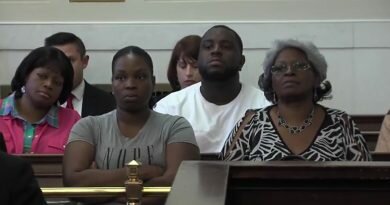blackmattersus.com
Could you please tell our readers about Jerome Skee Smith?
James Smith
Jerome was a 15-year-old high school student at the time of his arrest in 1985. He was charged with first degree murder, and he was allegedly identified by 3 witnesses that were in the general area.
blackmattersus.com
Most of our readers don’t know the details of the case. Could you tell us about the events of October 29, 1985? What really happened, and what is the official version?
James Smith
The official version was that Jerome was identified by 3 witnesses during the commission of an attempted armed robbery. During the preliminaries, Jerome presented an alibi defense. On the day of the incident, Jerome had a scheduled appointment at the Youth Study Center. The Youth Study Center is a juvenile detention facility. This scheduled appointment was to be conducted by a child psychologist by the name of Ms. Kathleen McKinney Thomas. She in fact interviewed Jerome that evening and conducted psychological tests on him. The incident as told by the state allegedly occurred around 4 o’clock. There’s significance in the time because Jerome’s alibi placed him and his mother at the Youth Study Center at 4:15pm, which meant that it took approximately 15 minutes from the time of the alleged incident to the time that Jerome arrived at the Youth Study Center. Jerome’s defense has always been that he was at the Youth Study Center during the commission of this crime. The witnesses at the Youth Study Center all came and testified in union to Jerome and his mother arriving at the center at 4.15. This was the trial version. Some 15 years later, Jerome’s defense team had obtained a part of the district attorney’s file. And in the district attorney’s file, it was discovered that the witnesses had made tape recorded statements as to their accounts of what transpired that evening. The tape recorded statements drastically change the trial version and created a contention for Jerome in 2001. The federal judge Ms. Berrigan served as Jerome’s defense lawyer in 1985. After reviewing the district attorney’s file, she had made herself available for testimonies in 2011. This testimony gives a detailed description of the new evidence and its importance. View Judge Berrigan’s testimony at wrongfullyconvictedpeople.com.
blackmattersus.com
Why do you think the trial was so serious for a teen?
James Smith
Well, Mr. Long was a prominent person in that neighborhood. And you’ve got to keep in mind, in 1985, racial tension was still prevalent and we had a trial that was divided between Blacks and whites. A lot of people supported the victim because he was well known in the neighborhood, he had been there and had a shop there for the second or third generation. And you had a lot of people that supported Jerome because of his alibi defense. Jerome was a promising high school basketball player at the time of his arrest. Because of the racial tension in New Orleans, a lot of people got involved. There was protesting on the day of the hearing, there was protesting during the trial, and I’m quite sure that there’s still news coverage of those protests. But to summarize your question, it was a significant time because the claim and the circumstances leading up to Jerome’s arrest were questionable. There were disparities involving in the initial description that the witnesses gave the day of the incident, there were people that were at the scene that initially heard the description, they only got involved after the description was broadcasted over the police radio. There was a lady in particular, her name was Ms. Rebecca Weber, she happened to be on the scene minutes after the shooting. And she heard a description that was broadcast over the police radio, but days later it was a different description. Because the description wasn’t the initial description she had heard, she became involved. That was a significant thing during the trial: the identification.
blackmattersus.com
Did anyone take up the fight for Jerome’s freedom before 2001?
James Smith
No. Basically, after Jerome’s direct appeal, he filed pro se to the courts. And in 1992, he filed an application for post-conviction relief, arguing that the D A. had withheld evidence that proves he’s innocent. This was the condition in 1992. When that application was sent to the courts, it was denied without a hearing. It wasn’t until 2001, that the then presiding judge Sharon Hunter opened the case back up, and afforded Jerome an opportunity to establish the existence of that D.A file. As a result of that hearing Jerome got a vacated sentence, his conviction got vacated. He was later reinstated, not because of the merits, his lawyers botched the claim, they never submitted in writing. And after that transpired, you know, Hurricane Katrina and the election, dealing with the new judges and all that unfolded and his case basically just stalled for a couple of years.
blackmattersus.com
In which prison is Jerome incarcerated?
James Smith
He’s in Angola, the Louisiana State Penitentiary.
blackmattersus.com
And who’s the lawyer involved in preparing the case for a new trial?
James Smith
Deidre K. Peterson is the attorney on record. She’s been working with Jerome since about 2008. She represented him at the post-conviction hearing in 2011 and she’s available for the juvenile hearing on October 14. She is well on record that it divides the court that she is basically about Jerome’s material. Jerome does all his communication, he does all his legal work, he does all his paralegal work, and just reads it to her and what Peterson does, is that she represents him in open court and she gives him the opportunity to do all the communication.
blackmattersus.com
So have you had any support from Black rights organizations?
James Smith
Unfortunately, we’ve never had any support from other organizations. We’ve written the NAACP over the years, we’ve written pro-bono lawyers in Louisiana, we’ve written capital defense lawyers, we’ve written the Innocence Project, we’ve written the Rainbow Coalition. We’ve set out asking for help numerous times over the years, and for whatever reason, no one has taken the initiative to get involved in this.
This is one of the situations we’re dealing with. On the 16th, Jerome’s intentions are that he wants to address the court himself. He wants to take charge of the whole proceeding and represent himself not in a pro se manner, but just to articulate in the record the necessary laws, the necessary facts and the necessary arguments to ensure that the record is ripe for appeal purposes. This has nothing to do with the stigma attached to jail house lawyers, this has nothing to do with whether he’s qualified or not, this is Jerome’s presentation. One of the things that’s going to be significant at this hearing is the person Jerome has become, the person Jerome is today. And in order to demonstrate that person, he has elected to address the court throughout this whole proceeding. We don’t know whether or not the judge is going to allow him to do it, but he will make the request and he will be prepared to address the court and answer all legal questions and make all legal arguments.
blackmattersus.com
Yes. This brings us to a very important question. Could you tell us who Jerome has become now? What does he think about this situation, what are his beliefs now and how is he coping?
James Smith
Well, Jerome is a very resilient individual. He has taken the situation and has educated himself. It’s very hard to really describe who Jerome is in one sentence. I can tell you this. Jerome is a very intelligent individual. He has taken his time and dedicated his life in educating himself with the laws of Louisiana and the laws governing his case. Jerome’s plan is to prove his innocence. He has support from his mother, he has support from his father and he has support from a few friends and family members. 31 years is a long time and for the most part, you’ll have to sit down and talk to Jerome yourself to have your own impression of him. I just cannot describe who he is, who he’s become and the person that I have come to know in one sentence. You have to meet Jerome, sit down with him and talk one-on-one and you’ll come out of that conversation with a clear impression, a clear understanding of who he is. I don’t believe his situation has deterred him, I don’t believe the situation has left him bitter, I don’t believe the situation has hindered his growth. I quote – and he always tells me this – when people ask Jerome about rehabilitation, Jerome maintains that he didn’t come to prison thinking he had to be rehabilitated. He came to prison understanding that if he didn’t grasp the meaning of the legal language that is in this justice system, that he wasn’t guaranteed an opportunity at freedom. Jerome has maintained his innocence and has created arguments through information that he has received from the district attorney’s office. He put his stance on his innocence, he’s driven by that stance, he’s determined and he’s encouraged by the minimal results that he gets. October 14, 2016, is the sentencing hearing and he will argue his innocence at that hearing as well.
blackmattersus.com
So has Jerome gotten the chance to talk to any journalists in the past? Has anyone been interested in his case?
James Smith
Liz Scott did an article for the New Orleans Magazine in 1987 and a follow-up in 1991. There was also a guy by the name of John Simerman, he did an article in 2011 in for the Times-Picayune on NOLA.com. They are the only people that have ever done any interview with him. He’s never spoken with any other journalists about his case, about his situation, about his life and how he’s coping.
blackmattersus.com
And if our readers wanted to send a message to Jerome, what would they do? Is it possible to send him a message in jail?
James Smith
You can email Jerome at jpay Jerome Smith 00114605. You can email him, you can write him a direct mail to the La State Prison, General Delivery, Angola, La. 70712.
blackmattersus.com
So what are you going to do now to help in securing his release? What steps do you plan to take?
James Smith
What we plan on doing is we’re going to
take this hearing and there’s a contention in Louisiana at the release of the juvenile in this sentencing. The Miller case says juveniles 17 or younger with life sentences is unconstitutional. This has triggered re-sentencing hearings for every juvenile in the state of Louisiana. What the state of Louisiana is offering is a sentence of life with parole. The thing about this sentence is that there’s no law in Louisiana that governs this sentence, no law in Louisiana upholds the sentence of parole as he’s innocent with a life sentence. And because of this law, Jerome doesn’t want to gamble on accepting a sentence of life with parole, when there’s no statute governing that sentence. His stand, Jerome wants to make a case of credit of time served. There are a string of cases in support of credit for time served, and at this hearing its Jerome’s intention to present these cases and these arguments and ask the judge to consider a sentence other than life with parole, particularly credit for time served or a responsive verdict of manslaughter which carries 40 years.
blackmattersus.com
So what would you like to say to people who are interested in coming to this protest and to people who would like to help?
James Smith
#FREESKEE. 31 years is a long time. Jerome went to prison when he was 15 years old. He has spent his whole 20s, all his 30s and he’s 47 years old to date. We just want to call for his day in court, whatever support, whatever help, just lend your support. We can’t have anything else to say, other than we want him home, that we hope for some justice. Read Jerome Skee Smith’s story. That has an ‘About’ portion that has the latest filings, it has the testimonies of Judge Ms. Berrigan and it has a detailed account of everything that transpired. You can go on that page and get a good understanding of what’s going on. Jerome has FREE SKEE T-shirts, he has a campaign at teespring.com
![]()









